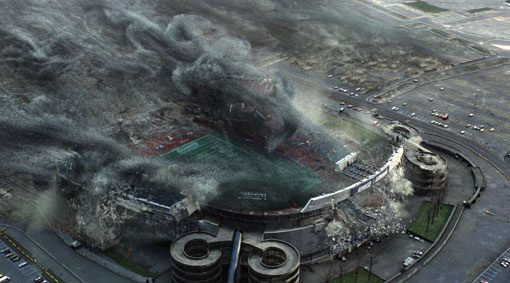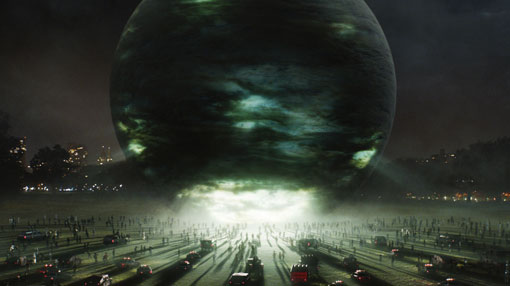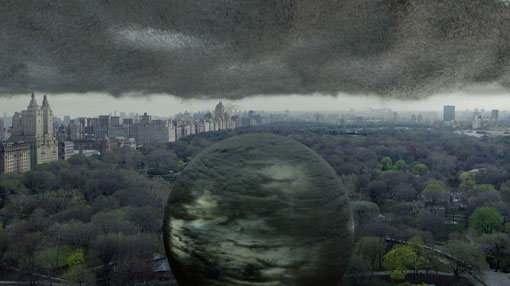Visualizing Destructive Forces for The Day the Earth Stood Still

So creating the right look and feel for a scary alien robot in the remake was especially important to Okun. It took five tries.
“At first, we ignored the original movie completely and designed Gort as a non-humanoid,” Sims says. “We went through many stages.” Gort was always imagined for this film as a completely CG character, and that first Gort was a four-legged creature.
“It didn’t move or look like anything anyone had ever seen,” Okun says. “We asked Weta Digital to show Gort’s scale, and to do so, they put a little man in the corner. Several of us were sitting in a pre-production office beating this thing to death when I said, ‘I have a stupid thing to say, but to me Gort is the little guy in the corner.’ And one by one, everyone agreed.”
The second version, designed by Sims and fleshed out at Weta into three dimensions, looked more like the 1951 robot, but was too generic. “He looked like a tube man at a gas station,” Okun says.
Version three looked like a guy in a suit. Version four was so close that Okun had the animators apply motion data captured from actor Shane Rangi, who had played several villains in the Lord of the Rings movies and the King Kong remake. “We put the sequence together and found another flaw,” Okun says. “[The CG character] had good angles and bad angles, and, unfortunately, the animatics always used his worst angle – dead-on front. I was depressed.” Version five was a tweak.
Okun was ready to model version five Gort when Joe Letteri, Weta executive producer, suggested camera moves and lighting changes that made the difference. “Gort was awesome,” Okun says. “The process was more difficult than I expected, but in the end, we’re paying homage to the old Gort and I think people will really dig it.”
So, what’s Gort made of? “Nothing we know,” Okun teases. “He’s organic and not organic, living and dead. The more everyone saw him, the more they liked him.” He appears in approximately 12 minutes of the film.
At Weta, Kevin Rafferty concentrated on supervising shots with Gort, the sphere, and the alien arriving in Central Park, and R. Christopher White supervised the destruction shots and helped develop the look of the sphere.
Twentieth Century Fox wouldn’t give up images of Gort for F&V’s article, but he appears several times in this international trailer available at YouTube.
“Gort has what we call inert and active phases,” Rafferty adds. “When he’s inert, he looks solid, like something between metal and polished stone.”
And when he’s active?
The trailers provide a quick blink at his active state, but describing it further is a SPOILER. You’ve been warned.
“The polished stone suggests that there is a substructure underneath,” Rafferty says. “When he becomes active, we get the hint that he’s not made of one solid thing. He’s made up of what we called aphids – cross-hatched, interwoven aphids.”
To create that impression, the crew placed a series of texture maps over and around the surface of the Gort geometry. “The texture maps were pathways and guidelines for how the particles would flow,” Rafferty says. The particles controlled the nanobot aphids.
“Our trickery was that we had multiple layers of particles traversing the surface, rather than creating a whole volume for Gort,” Rafferty says. “They stay in shape until one quintessential moment when the aphids are unleashed and he dissolves.”
When Gort raises his arms, the aphids flow from his wrist to his forearm and then his head dissolves. The aphids begin eating and as they eat, they multiply. And that creates the swarms that destroy Giants Stadium and the truck.
In one shot during the film, a power-of-10 zoom shows the tiny animals chomping away. “They kind of look like a metallic robot version of a housefly, for lack of a better comparison,” Rafferty says. “They have mean jaws. We called them aphids because of their almost microscopic nature.”

“We based the rules on basic flocking dynamics,” White says. For example, as with flocks of birds, the leader of the flock can change, which causes the flock to change directions. Similarly, the particles can flock into ribbon shapes. The flock can move away from something, break up and flow together again. “Each particle is aware of its neighbors and what the group is doing,” he says.
To add density, the crew often layered separate simulations. “Sometimes, we’d run multiple simulations, put those into one final simulation, and render them,” White says. “Many times, we’d render different layers and let compositors create the balance.”
External scripts helped the technical directors (TDs) light the swarms. “It was difficult to get coherent highlights on those little shapes,” White says. “So we had a standalone program that would bring in the particle simulations and set control values for the aphids by looking at surrounding neighbors. It was almost as if we built a surface – to apply consistent specular highlights, we calculated the normals as if we had a large surface. So TDs could choose the surface-like normals, individual aphid normals, or a combination.”
Destruction software, which has evolved at Weta since King Kong, allowed the crew to break up objects that fell apart using rigid body dynamics. “We had a dedicated destruction team that worked with the simulation team doing the aphids and the environment TDs,” White says.
A similar process destroyed the truck. “You see the aphids wipe the road clean,” White says. “So we had to model the gravel in the ground and add litter. We wanted to show this area as very polluted, so we added smokestacks, trash on the side of the road, and factories.”

Sims’ artwork, which he created using Autodesk Softimage XSI, showed an internally lit globe with stormy skies. “It was an idea Scott [Derrickson] had from the beginning,” Sims says. “I projected textures and stormy illustrations onto a sphere, painted it, added a glow and hoped someone would figure out how to make it work.”
Making it work was a two-part problem. Okun had to make the spaceship work for the actors on location, and Weta had to make it work in post.
“I hate spheres,” Okun says. “How do you direct actors to interact with a 300-foot tall sphere? When you see the military gathering and Helen [Jennifer Connelly] waiting to see what happens, we wanted them 20 feet from where the alien emerges, which put them 100 feet under an overhang. No one would be there. So we had a lot of imagery and size-relationship problems.” To help the actors grasp the orb’s immensity, Okun provided on-set wedges covered in green.
After ruling out particle simulations and fractals, the crew at Weta settled on creating the sphere’s organic look using layers of animated, high-resolution texture maps. “Imagine a diagram of the earth – a cross-section showing the magma,” White explains. “We had four main layers. We extruded a core layer with one texture into a volume of clouds, and then added layers outside that. It was amazing how much the look of the spheres changed when you changed the inner layers.”
The layer in the middle was static. The other three layers constantly warped, rotated, and counter-rotated at different speeds depending on parameters set by TDs who could also affect density and color. They settled largely on a palette of cyans and greens that the internal lights fringed with warm oranges and yellows. “We wanted to create the feeling that this thing wasn’t necessarily a ship,” Rafferty says. “It could be alive. Something could be in there.”

Although the film’s multiple spheres, which range in size from one foot to 900 feet in diameter, needed to have a similar look, the TDs altered the spheres on a shot-by-shot basis. Animators controlled the internal point lights to create the proper moods. “Sometimes we see frenetic movement of the lights inside,” White says. “Sometime they interact with the surrounding environment.”
When Klaatu emerges from the sphere-ship, the lights converge at the bottom and become very bright. He’s wearing a protective suit that gives him a strange form and has a similar sense of internal light as the sphere. “The suit is almost gelatinous,” says Rafferty, “with a menacing shape to the head that has internal venous structures that light up from time to time. It’s all CG.”
At first, people believe the suit is the alien, but it falls apart and inside is the newborn but adult Klaatu. “We see the CG alien suit for about a minute, and the CG newborn for about 30 seconds,” Okun says. “We used a series of photos of Keanu to show him evolving as the hours pass. He’s an amazing actor.”
Okun hopes that in the end, people viewing the film will think of the effects as elegant, organic, and unique. “Pushing something to look organic doesn’t sound like much – except we were creating aliens and spaceships,” he says. “It’s a huge challenge to make something spectacular in a way that’s like when you hike to the top of a mountain and see all the clouds and it feels magical, but real. That’s the feeling we wanted to create.”
The feeling, for example, that an eight-year-old in the audience might remember for a very long time.
Did you enjoy this article? Sign up to receive the StudioDaily Fix eletter containing the latest stories, including news, videos, interviews, reviews and more.










Leave a Reply